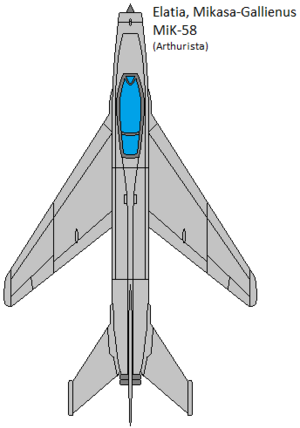Mikasa Gallienus MiK-58: Difference between revisions
Arthurista (talk | contribs) mNo edit summary |
Arthurista (talk | contribs) mNo edit summary |
||
| Line 20: | Line 20: | ||
|} | |} | ||
The '''Mikasa Gallienus MiK-58''' ([[NATA]] reporting name: '''Fishhook''') is a lightweight fighter-bomber originally developed by [[Elatia]] in the late-1950's based on the [[Suvarova]]n {{wp|MiG-21}}. It was Elatia's first fighter capable of attaining Mach 2 speed in level flight. This simple fighter was produced in very large quantities and until the late-1970's formed the backbone of the Elatian Air Force. Its international counterparts include the [[Vannois]]ian {{wp|Dassault Mirage III|Mirage III}}, the [[Arthurista]]n [[Greenwich Tigress and Super Tigress|Greenwich Super Tigress]], the [[Ghant]]ish {{wp|Saab 35 Draken|E-35 Draco}} and the [[Mutul]]ese {{wp|Northrop F-5|K'akmul 5}}. | The '''Mikasa Gallienus MiK-58''' ([[NATA]] reporting name: '''Fishhook''') is a lightweight fighter-bomber originally developed by [[Elatia]] in the late-1950's based on the [[Suvarova]]n {{wp|MiG-21}}. It was Elatia's first fighter capable of attaining Mach 2 speed in level flight. This simple fighter was produced in very large quantities and until the late-1970's formed the backbone of the [[Elatian Air Force]]. Its international counterparts include the [[Vannois]]ian {{wp|Dassault Mirage III|Mirage III}}, the [[Arthurista]]n [[Greenwich Tigress and Super Tigress|Greenwich Super Tigress]], the [[Ghant]]ish {{wp|Saab 35 Draken|E-35 Draco}} and the [[Mutul]]ese {{wp|Northrop F-5|K'akmul 5}}. | ||
The MiK-58's designers were impressed by the Fishbed's high power-to-weight ratio. However, they were not minded to adopt the delta-wing of the latter, which conferred significant acceleration and climb rates, but at the cost of turning ability as well as take-off length. What Elatia needed was not so much a dedicated interceptor, but an all-purpose fighter. Accordingly, Elatian designers decided to use the more mature technology of swept-back wings in order to improve the aircraft's prowess in a traditional dogfight, which in the era before reliable radar-guided beyond-visual-range missiles remained the primary form of air-to-air combat. | The MiK-58's designers were impressed by the Fishbed's high power-to-weight ratio. However, they were not minded to adopt the delta-wing of the latter, which conferred significant acceleration and climb rates, but at the cost of turning ability as well as take-off length. What Elatia needed was not so much a dedicated interceptor, but an all-purpose fighter. Accordingly, Elatian designers decided to use the more mature technology of swept-back wings in order to improve the aircraft's prowess in a traditional dogfight, which in the era before reliable radar-guided beyond-visual-range missiles remained the primary form of air-to-air combat. | ||
Revision as of 15:45, 10 July 2021
| Mikasa Gallienus MiK-58 | |
|---|---|

| |
| MiK-58 | |
| Role | Lightweight fighter bomber |
| Manufacturer | Mikasa Gallienus |
| First flight | 1957 |
| Introduction | 1959 |
| Status | In service |
| Primary user | Elatian Air Force |
The Mikasa Gallienus MiK-58 (NATA reporting name: Fishhook) is a lightweight fighter-bomber originally developed by Elatia in the late-1950's based on the Suvarovan MiG-21. It was Elatia's first fighter capable of attaining Mach 2 speed in level flight. This simple fighter was produced in very large quantities and until the late-1970's formed the backbone of the Elatian Air Force. Its international counterparts include the Vannoisian Mirage III, the Arthuristan Greenwich Super Tigress, the Ghantish E-35 Draco and the Mutulese K'akmul 5.
The MiK-58's designers were impressed by the Fishbed's high power-to-weight ratio. However, they were not minded to adopt the delta-wing of the latter, which conferred significant acceleration and climb rates, but at the cost of turning ability as well as take-off length. What Elatia needed was not so much a dedicated interceptor, but an all-purpose fighter. Accordingly, Elatian designers decided to use the more mature technology of swept-back wings in order to improve the aircraft's prowess in a traditional dogfight, which in the era before reliable radar-guided beyond-visual-range missiles remained the primary form of air-to-air combat.
The MiK-58's most advanced feature was its turbojet engine which, aside from is normal reheat function, has a second fuel pump to allow for the use of an 'Enhanced Power Rating' (EPR) mode. The latter, which could only be sustained for two minutes, produced up to 97.5kn of thrust and allows the MiK-58 to attain a power-to-weight ratio of nearly 1:1, an impressive achievement for its time. Its disadvantages include the primitive ranging radar mounted within the small shock cone (which is incapable of being used to direct radar-guided missiles), small payload and in particular its combat endurance. Despite periodic upgrades in both internal and drop tank fuel capacity, the MiK-58 remains primarily a short-range fighter optimised for providing tactical air cover over the battlespace.
In the air-to-air role, the MiK-58 is usually equipped with two short-range heat-seeking missiles, plus two drop tanks. It was also designed from the outset with a secondary ground-attack capability, carrying bombs between 250-500kg in weight as well as rocket pods.
The MiK-58 has largely been phased out by the Elatian Air Force, replaced by the Mikasa Gallienus MiK-70 Visko and other models. However, significant quantities remain in storage in the event of an emergency. The latest version, the MiK-58 MS, is largely intended as a ground attack fighter, equipped with a targeting pod which allows it to employ precision-guided weapons, although it retains the ability to act as an auxiliary fighter in close engagements.
Specifications (MiK-58MS)
- Length: 14.5m
- Wingspan: 9.01m
- Wing area: 23.33m2
- Height: 4.1m
- Crew: 1
- Gross weight: 8.8 tonnes
- Powerplants: 1 x Nekota-33 turbojet engine, 44kn dry, 70kn with afterburner, 97.5kn emergency power
- Combat range: 850km
- Ferry range: 2,000km
- Top speed: Mach 2 at altitude
- Armaments: 2x 23mm twin-barrel Gast guns with 120 rounds, 2,000kg external stores, 5x pylons
- Sensors: Mikasa A04 ranging radar